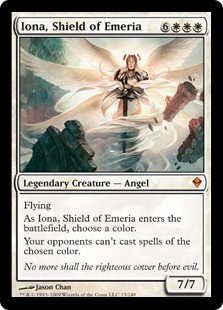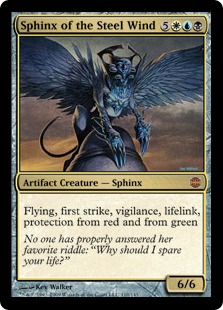Entomb recently came off the banned list in Legacy, to much attention but little effect. In this week’s article, I’ll talk about two applications of the incredible instant: a traditional Reanimator strategy and the most busted creature-but-actually-just-a-combo-piece since Worldgorger Dragon, the Protean Hulk.
Reanimator strategies and Entomb
Reanimator has traditionally been a powerful and borderline-busted strategy in formats with deep card pools. Consider this old article on playing Benzo by Tom Guevin. Benzo was a multifaceted reanimator deck played in old Extended. Here’s what they were working with:
19 Swamp
3 Rishadan Port
1 Avatar of Woe
1 Multani, Maro Sorcerer
1 Verdant Force
1 Squee, Goblin Nabob
2 Krovikan Horror
1 Nether Spirit
4 Zombie Infestation
4 Entomb
3 Buried Alive
4 Vampiric Tutor
4 Reanimate
2 Animate Dead
4 Exhume
4 Duress
1 Contamination
1 Massacre
Sideboard:
2 Massacre
1 Terror
1 Bone Shredder
1 Ascendant Evincar
1 Avatar of Woe
1 Marauding Knight
3 Phyrexian Negator
2 Contamination
1 Phyrexian Furnace
1 Null Rod
1 Perish
It could win by the disheartening first turn play of Dark Ritual, Duress, Entomb for Verdant Force or Multani, Maro Sorcerer, and a Reanimate. Blowing eight life wasn’t an issue when the opponent effectively started the game down their best card and facing a two- or three-turn clock. Alternately, the deck could drop a Zombie Infestation on the second turn, use Buried Alive for a Squee and two Krovikan Horrors, and then, through artful stacking of Horrors, make three Zombies per untap phase. Decks with a long-term plan for winning would be hard-pressed to beat the free recursion. Thanks to the selectiveness of Vampiric Tutor, Benzo could also find and put out Contamination, fed either by Nether Spirit popping in and out or a Verdant Force making guys for the lockout.
While we lack Vampiric Tutor, which is probably a good thing for Legacy, we’ve got a lot of the other cards that made Benzo so good. Further, we’ve got much better targets for reanimation. Entomb wouldn’t be such a big deal if this card weren’t also around:

So on the first turn, you can let your opponent know they’ll be starting the game facing down a 7/7 flier that makes all of their removal blank or even worse, invalidates their entire deck (sorry, Merfolk!). To be fair, Iona isn’t a total game-over, since later in the game, reanimating her might be impossible if you’re down on life or the opponent can race it. That’s why we can also pack this guy:

Robokroma can immediately turn around a game where your life total is a liability, since it can attack and stay untapped to play defense and has Protection From Threshold. It’ll still bite it to Swords to Plowshares, but that’s sort of the general weakness of Reanimator at times. The other two options, both of which are solid, are Empyrial Archangel, which absorbs a lot of burn damage and attackers while being impervious to removal; and Blazing Archon, a real shut-down for Dredge decks and anything else that has a hard time removing single creatures.
Unfortunately, Reanimator has some real problems. First, counterspells can really throw the deck for a loop because setting up Entomb and a reanimation spell, especially if powered by Dark Ritual, can be very card-intensive. Luckily, Duress answers that well, and gives you an idea of what the opponent is holding to kill your fatties. Swords to Plowshares and Path to Exile present potent threats for the same reason, since they cost far less resources than your creature. Finally, and obviously, graveyard hate can ruin your day; thanks to Dredge being such a public enemy, Wizards has seen it fit to put a new and more frustrating graveyard hate card in every set. Instead of just Phyrexian Furnace in the old extended, you now have Leyline of the Void, Planar Void, Tormod’s Crypt, Relic of Progenitus and Ravenous Trap, to name a few popular ones. Chain of Vapor and Pithing Needle can answer many of these cards. You’re also unlikely to face any in the first game, making the win equation much like Dredge – win the first game and then you just have to get lucky in one of the next two and dodge the hate.
Speaking of Dredge, let’s consider why you’d want to play this over that graveyard monster. Reanimator gives more opportunities to interact with the opponent through Duress and the like. It’s got a stable manabase and is much simpler to play. I think it’s also easier for the deck to play around multiple graveyard hate cards, because you can bait the opponent with a reanimation spell and then just reload. For example, Exhume does not target; if an opponent has something like a Relic of Progenitus in play, one can cast Exhume, make them blow their removal spell and then, with Exhume still on the stack, cast another Entomb or use Putrid Imp or Zombie Infestation to dump another guy in the graveyard. It’s a sick psychological blowout for the opponent when you end up with a creature in play anyway (thanks to Master Shake on The Source for pointing out this interaction).
If I were playing Reanimator, I’d look at this third-place list from Stefano Venturini, from a 135-player event in Italy recently:
Creatures (6)
Lands (17)
Spells (38)
- 4 Brainstorm
- 3 Mystical Tutor
- 4 Duress
- 3 Reanimate
- 4 Dark Ritual
- 2 Intuition
- 3 Exhume
- 4 Entomb
- 4 Careful Study
- 1 Wipe Away
- 2 Ponder
- 4 Thoughtseize
Sideboard

One could also give a Benzo deck a try, maybe with something like this:
Creatures (7)
- 1 Squee, Goblin Nabob
- 1 Nether Spirit
- 1 Blazing Archon
- 1 Oona, Queen of the Fae
- 1 Sphinx of the Steel Wind
- 2 Iona, Shield of Emeria
Lands (22)
Spells (31)

This is, of course, a rough list but demonstrates some of the avenues that Benzo used. Oona can replace Verdant Force as a castable beater that can feed a Contamination. You can imagine scenarios where an opponent feels comfortable with that double Swords to Plowshares hand, only to face down a first-turn Contamination backed by a turn 2 Zombie Infestation and lose with all the tools still in their hand. The Shizo is there for a miserly land that lets Iona and Oona beat in past blockers. You could conceivably also run Avatar of Woe (or Jeff Spicoli, Avatar of Whoaah!).
Entomb With Protean Hulk
Protean Hulk, at first glance, appears to be a creature. It has a power and toughness, a creature type, even a picture that shows some sort of fearsome beast. Make no mistake, though; this guy was only ever meant to inspire Johnny-esque creature setups that result in killing the opponent. You remember him from the Flash era, but it’s gotten a new life through Entomb. The goal is to bin the Hulk and then pull it back with either Necromancy or Footsteps of the Goryo, both of which conveniently kill the Hulk again and set up a combination. The big advantage of Entomb is that you only need to run one Hulk, so there are a lot fewer dead draws. Let’s look at the standard Hulk kills:
Requires:
4 Disciple of the Vault
4 Shifting Wall
3 Phyrexian Marauder
Goal: Get the four Disciples (though three is enough) into play with the Hulk. Also get the X-cost artifact creatures. The artifacts check their power and toughness, which is zero, decide to peace out instead of remain in play and trigger the Clerics. End result, the opponent loses at least 21 life.
Advantages: Not disrupted by spot removal or graveyard removal. Idiot-proof to pull off. The combo pieces have some advantage on their own and can be cast without the combination.
Disadvantages: Requires eleven cards (!). Can only deal 28 points of lifeloss, meaning lifegain can get someone out of the kill range.
Requires:
1 Reveillark
1 Body Double
1 Carrion Feeder
1 Bile Urchin
Optional:
1 Body Snatcher
1 Sylvan Safekeeper
Goal: Get the Body Snatcher or Body Double and Carrion Feeder from the first Hulk activation. The Snatcher lets you discard a drawn combination piece (aside from Carrion Feeder). Either reanimate the Hulk or copy it with the Double. Sacrifice that Hulk to the Carrion Feeder to get Reveillark and Bile Urchin. The Urchin is sacrificed and the Reveillark feeds the zombie. Reveillark brings back the Body Double and Bile Urchin on its way out. Bile Urchin is sacrificed again. Body Double copies Reveillark. In a strange twist, the Body Double/Reveillark is sacrificed to Carrion Feeder and the reanimation trigger sees the Body Double in the graveyard, eligible to be brought back again. By repeating this loop, one can create an arbitrarily large Carrion Feeder and deal any amount of life loss to the opponent.
Advantages: difficult to disrupt; only removal pointed at Carrion Feeder can stop it. Getting the Snatcher and Safekeeper with the first Hulk activation means that you can give Shroud to the Feeder as many times as you have lands, making the combination impervious to spot removal. If the combo is disrupted, one can still get Reveillark and a Carrion Feeder to beat down. Requires very few slots in the deck.
Disadvantages: Very susceptible to graveyard hate. Complex interactions make screwing up easier.
The Sliver Kill
Requires:
4 Virulent Sliver
1 Heart Sliver
Optional:
1 Winged Sliver
1 Crystalline Sliver
Goal: Get the four Virulent Slivers and the Heart Sliver. Attack in with hasted Slivers and give the opponent twenty poison counters. Alternatively, one can get the Winged Sliver and fly over blockers or Crystalline Sliver to avoid spot removal. Shadow Sliver provides twelve unblockable poison counters.
Advantages: Does not rely on the graveyard. Individual pieces can be cast if drawn and can kill the opponent without the help of the combo (which is easy to do with two Virulent Slivers in play).
Disadvantages: Spot removal and burn is very good. Heart Sliver needs a way to sacrifice the Hulk before the end of the turn or else the Haste is wasted.
The kill of choice right now seems to be the Reveillark combination, though the Slivers are a fine option too. The Slivers are a great option for the sideboard, since opponents will likely sideboard in graveyard hate and might be caught off guard. In any case, the opponent will be aiming the graveyard disruption at the Hulk when you attempt to reanimate it, making an extra Protean Hulk or two on the sideboard a smart option.
The Hulk combo is powerful but fair. After extensive testing around with it, I’ve found that it’s good, but not too good. The deck can play a remarkable control game where it can sit back and just sandbag spells and play lands, blasting off at the last moment. Patrick Chapin list, developed by my team, has been pretty reliable in testing:
Creatures (6)
Lands (18)
Spells (36)

It’s important to get Cabal Therapy in the graveyard if you suspect the opponent is playing Swords to Plowshares. Since Necromancy will only kill your Hulk at the end of the turn, there’s a window to Path to Exile or Sword it. Therapy lets you Necromancy and then flash back the discard spell without passing priority after the Necromancy resolves. Since the sacrifice is part of the cost, there is no time when the opponent can exile the Hulk.
Deep Analysis makes a fine Entomb target and is superb as a Mystical Tutor target. Getting past a wall of counterspells requires several discard spells of your own, so casting and flashing back the draw spell gives the deck four more cards with which to outfox an opponent. Pact of Negation gives a lot of disruptive power, but I chose Duress instead because the value of peeking was enormous and I could use it before I went off, unlike Pact, which basically requires you to be going for the kill that same turn.
I’ve personally favored Sensei’s Divining Top in the deck over cards like Pact of Negation or Ponder. It makes sure you don’t draw a combo piece and lets you fight against discard spells. Patrick’s list packs lots of dual lands, but one can actually shave it all away down to just two or three Underground Seas, six to eight fetchlands and a pile of basic lands. One test deck of mine had seven basics, making the fight against Canadian Threshold very easy (as Stifle was their only relevant card at that point).
The Hulk combination gives a lot of room for a player to outsmart an opponent, much like Worldgorger Dragon did. One can tinker with other kills (like four Phyrexian Dreadnought and a Sylvan Safekeeper, three Meddling Mages, etc.) to stay ahead of an opponent’s hate. The sideboard should be molded on fighting the hate cards, so Pithing Needle and Reverent Silence are both great choices. One can also experiment with Pernicious Deed or Tombstalkers as alternative ways to play around hate, though I don’t advise a fully-transformational sideboard because it sucks up so much space and is rarely worth it.
Wrapping It Up; Different Entomb Options
Entomb is great to facilitate reanimation, but that’s hardly the limit of its power. It can also:
• Get Life from the Loam or Genesis for a Rock-style deck.
• Power an Auriok Salvagers-based recursion strategy with reanimation, getting Lion’s Eye Diamond or Pyrite Spellbomb as combo pieces.
• Make a dedicated Contamination lock deck.
• Get Golgari Grave-Troll in a Dredge deck.
If you’ve been playing around with Entomb, drop me an email or post on the forums about your experiences with the card. Is Entomb too powerful with Iona? Is there a better Protean Hulk build? Can Entomb power up other combinations that I’ve overlooked? I’m looking forward to more innovative applications for the newly-playable spell in Legacy.
Until next week…
legacysallure at gmail dot com

